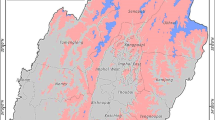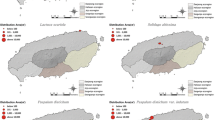Abstract
An exploratory survey was conducted on the uses and role of invasive alien species (IAS) to local livelihoods in the Rema-Kalenga Wildlife Sanctuary in the northeastern hilly region of Bangladesh. Vegetation was sampled in 50 quadrates, each 10 m×10 m, and 25 line transects, each 50 m×20 m, through a combination of random and systematic sampling. Group discussions were also arranged with fifty local inhabitants (17 % of the total inhabitants) to learn the various uses of IAS. A total of 17 alien plant species belonging to 10 different families, of which Leguminosae constitutes the highest number (5 species), include tree (53%) followed by herb (12%), shrub (12%) and others (weed, climber and palm). The majority of the identified species were found to be used for fuel, followed by timber production, medicinal or curative uses, fodder, and many others. In addition to providing various forest products, alien tree species planted in forest plantation help provide many vital ecosystem services such as soil amelioration through nitrogen fixation. It is true that the alien species have some negative impacts on local ecosystems, and not all of them are harmful. Therefore, a national programme must be initiated to distinguish the harmful from the harmless species and to identify the uses and impacts of the former and latter.
Similar content being viewed by others
References
Ambasht, R.S. 1979. A Textbook of Plant Ecology. Students Friends and Co. Lanka, Varanasi, India. Pp.276.
Barua S.P., Khan M.M.H. and Reza A.H.M.A. 2001. The Status of Alien Invasive Species in Bangladesh and their Impact on the Ecosystems. In: Balakrishna, P. (ed), Alien Invasive Species-Report of workshop on Alien Invasive Species. IUCN Regional Biodiversity Programme of Asia, Colombo, Sri Lanka.
Biswas, S.R. 2003. Invasive Plants of Sundarbans. In: Interim Report under SBCP project, IUCN Bangladesh. Pp.34.
Biswas S.R., Choudhury J.K., Nishat A., Rahman M.M. 2007. Do Invasive Plants Threaten the Sundarbans Mangrove Forest of Bangladesh? Forest Ecology and Management 245(1–3):1–9.
Campbell S. 2005. A Global Perspective on Forest Invasive Species: the problem, Causes, and Consequences. In: McKenzie, et al. (eds.), The Unwelcome Guests. Proceedings of the Asia-Pacific Forest Invasive Species Conference. FAORAP, Bangkok. Pp.9–10.
GISP. 2004. Tropical Asia Invaded: the Growing Danger of Invasive Alien Species. The Global Invasive species programme. Pp.64.
Hossain M.K. and Pasha M.K. 2001. Alien Invasive Plants in Bangladesh and their Impacts on the Ecosystem. In: Assessment and Management of Alien Species that Threaten Ecosystems, Habitats and Species (CBD Technical Series No. 1). Secretariat of the Convention on Biological Diversity, Montreal, Canada. Pp.73–75.
Islam A.K.M.N. 1991. Two Centuries of Plant Studies in Bangladesh and Adjacent Regions. Asiatic Society of Bangladesh, Dhaka, Bangladesh. Pp.299.
Islam M.M., Amin A.S.M.R. and Sarker S.K. 2003. National Report on Alien Invasive Species of Bangladesh. In: Pallewatta, et al. (eds.), Invasive Alien Species in South-Southeast Asia: National Reports & Directory of Resources. Global Invasive Species Programme, Cape Town, South Africa. Pp.7–24.
IUCN. 2003. Status of the Ecological Integrity of the Sundarbans. IUCN Bangladesh Country Office. Pp.80.
Karim S.M.F. 2008. Intergenerational Access to Forest Resources: a Compromised Scenario in Rema-Kalenga Wildlife Sanctuary, Bangladesh. B.Sc Thesis. Department of Forestry and Environmental Science, Shahjalal University of science and Technology, Bangladesh. Pp.70.
Kenis M., Rabitsch W., Auger-Rozenberg M.A. and Roques A. 2007. How can Alien Species Inventories and Interception Data Help us Prevent Insect Invasions? Bulletin of Entomological Research 97:489–502.
Lowe S., Brown M., Boudjelas S., and Poorter M.D. 2000. 100 of the World’s Worst Invasive Alien Species: a Selection from the Global Invasive Species Database. The Invasive Species Specialist Group (ISSP) of Species Survival Commission of IUCN, Auckland, New Zealand. Pp.12.
McNeely J.A. 2001. The Great Reshuffling: Human Dimensions of Invasive Alien Species. IUCN, Gland, Switzerland and Cambridge, UK. Pp. 242.
McNeely J.A., Mooney H.A., Neville L.E., Schei P. and Waage J.K. 2001. A Global Strategy on Invasive Alien Species. IUCN, Gland, Switzerland and Cambridge, UK. Pp. 50.
Mooney H.A. and Hobbs R.J. 2000. Invasive Species in a Changing World. Island Press, Washington, D.C.
Mukul S.A., Uddin M.B. and Tito M.R. 2006. Study on the Status and Various Uses of Invasive Alien Plants Species in and around Satchari National Park, Sylhet, Bangladesh. Tiger paper 33(4): 28–32.
NACOM. (Nature Conservation Management) 2003. Site Level Appraisal for Protected Area Co-Management. Rema-Kalenga Wildlife Sanctuary. Prepared for International Resources Group, Dhaka, Bangladesh.
Nishat A., Huq S., Imamul M., Barua S., Reza P., Ali A.H.M. and Khan M.A.S. 2002. Bio-ecological Zones of Bangladesh. IUCN, Bangladesh. Pp. 141.
Parker I.M., Simberloff D., Lonsdale W.M., Goodell K., Wonham M., Kareiva P.M., Williamson M.H., Von Holle B., Moyle P.B., Byers J.E., Goldwasser L. 1999. Impact: toward a Framework for Understanding Ecological Effects of Invaders. Biological Invasions 1:3–19
Raghubanshi A. S., Rai L. C., Gaur J. P. and Singh J. S. 2005. Invasive Alien Species and Biodiversity in India. Current Science 88(4): 539–440.
Uddin M.Z. 2002. Exploration, Documentation and Germplasm Collection of Plant Genetic Resources of Rema-Kalenga Wildlife Sanctuary (Habiganj) in Bangladesh. Ph.D. Thesis, University of Dhaka.
Uddin M. Z. and Roy S. 2007. Collection and Management of Selected Medicinal Plants in Rema-Kalenga WS. In: Fox, et al. (eds.), Making Conservation Work: Linking Rural Livelihoods and Protected Area Management in Bangladesh. Nishorgo Support Project, Dhaka, Bangladesh.
Wittenberg R. and Cock M.J.W. 2001. Invasive Alien Species: A Toolkit of Best Prevention and Management Practices. CAB International, Wallingford, Oxon, UK. Pp.228.
Author information
Authors and Affiliations
Corresponding author
Rights and permissions
About this article
Cite this article
Rana, M.P., Akhter, F. Uses of invasive alien plant species in Rema-Kalenga Wildlife Sanctuary of Bangladesh. J. Mt. Sci. 7, 380–385 (2010). https://doi.org/10.1007/s11629-010-1008-4
Received:
Accepted:
Published:
Issue Date:
DOI: https://doi.org/10.1007/s11629-010-1008-4




